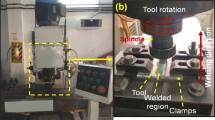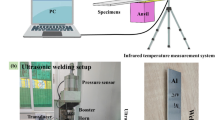Abstract
Hybrid friction stir welding, adopting an external pre-heat source in front of the friction stir welding (FSW) tool, is known as a way of overcoming the disadvantages of conventional FSW; lack of plastic flow and excessive tool wear. In joining of aluminum alloy to steel, presence of intermetallics (IMC) is essential, but its excessive growth can degrade the joint quality by its brittleness. In this study, joining of 2.5 mm thick Al5052 aluminum alloy and 1.4 mm thick DP590 high strength steel has been carried out by FSW and TIG assisted hybrid friction stir welding (HFSW) through experiments and numerical analysis. Joints characteristics of two process was compared to optimize the process parameters. A 3-D model was developed to estimate the thermal elastic–plastic characteristics of the joints. It was confirmed that the joint efficiency of HFSW joints has been improved to 84% than that of FSW (74%). 2.74 μm thickness of IMC layer was formed in HFSW joints and satisfied the permissible thickness (under 10 μm). The maximum residual stress (σzz) in welding direction was slightly higher at the HFSW joints than at the FSW joints. The overall results from experiment and simulation confirmed that HFSW is an effective way of joining Al5052 to DP590.
Graphic Abstract












Similar content being viewed by others

Abbreviations
- k:
-
Thermal conductivity
- \({\rho }\) :
-
Density
- C:
-
Specific heat
- T:
-
Welding temperature
- t:
-
Time variable
- \(\upvarepsilon^{e}\) :
-
Elastic strain
- \(\upvarepsilon^{P}\) :
-
Plastic strain
- \(\upvarepsilon^{T}\) :
-
Thermal expansion strain
- \(\eta_{h}\) :
-
Fraction of total generated heat transferred to the workpiece
- \(\eta_{m}\) :
-
Fraction of mechanical energy
- A:
-
Contact area of workpiece surrounding the pin
- V:
-
Volume of presumed shear layer adjoining to the pin
- R:
-
Radial distance of the shear layer from the tool center
- \({\theta }\) :
-
Inclination with the welding direction
- w:
-
Rotational speed of the tool
- U:
-
Welding speeds of the tool
- \(\tau_{y}\) :
-
Temperature dependent shear yield strength of workpiece
- \(\sigma_{y}\) :
-
Yield strength based on Von Mises yield criteria
- P :
-
Axial force
- r :
-
Radial distance from axis of the tool
- \(\delta\) :
-
Frictional sliding
- \(\mu_{f}\) :
-
Coefficient of friction along the shoulder–workpiece interface
- d :
-
Energy distribution coefficient
- \(\eta\) :
-
Energy efficiency
- P W :
-
Arc power
- r eff :
-
Effective radius of TIG arc on top surface of the workpiece
- \(\sigma_{xx}\) :
-
Perpendicular residual stress, parallel to the weld line
- \(\sigma_{yy}\) :
-
Vertical directional residual stress to the weld line
- \(\sigma_{zz}\) :
-
Longitudinal residual stress, perpendicular to the weld line
- \(\sigma_{EQ}\) :
-
Equivalent residual stress
- \(\varepsilon^{P}_{EQ}\) :
-
Equivalent plastic strain
References
M.M. Atabaki, M. Nikodinovski, P. Chenier, J. Ma, M. Harooni, R. Kovacevic, Welding of aluminum alloy to steels: an overview. J. Manuf. Sci. Prod. 14, 59–78 (2014)
Kattner, U.R., 1990. In: binary alloy phase diagrams. Materials Park, OH: ASM International; 147
W. Zhang, D. Sun, L. Han, W. Gao, X. Qiu, Characterization of intermetallic compounds in dissimilar material resistance spot welded joint of high strength steel and aluminum alloy. ISIJ Int. 51(11), 1870–1877 (2011)
L. Xu, L. Wang, Y.C. Chen, J.D. Robson, P.B. Prangnell, Effect of interfacial reaction on the mechanical performance of steel to aluminum dissimilar ultrasonic spot welds. Metall. Mater. Trans. A Phys. Metall. Mater. Sci. 47A, 334–346 (2016)
H.C. Chen, A.J. Pinkerton, L. Li, Z. Liu, A.T. Mistry, Gap-free fibre laser welding of Zn-coated steel on Al alloy for light-weight automotive applications. Mater. Des. 32, 495–504 (2011)
L. Agudo, D. Eyidi, C.H. Schmaranzer, E. Arenholz, N. Jank, J. Bruckner, A. Pyzalla, Intermetallic FexAly-phase in a steel/Al-alloy fusion weld. J. Mater. Sci. Technol. 42, 4205–4214 (2007)
H. Springer, A. Kostka, E.J. Payton, D. Raabe, Kaysser-Pyzalla, G. Eggeler, On the formation and growth of intermetallic phase during interdiffusion between low-carbon steel and aluminum alloys. Acta Mater. 59, 1586–1600 (2011)
A. Das, M. Shome, S.F. Goecke, A. De, Joining of aluminum alloy and galvanized steel using a controlled gas metal arc process. J. Manuf. Process. 27, 179–187 (2017)
N. Chen, H.P. Wang, B.E. Carlson, D.R. Sigler, M. Wang, Fracture mechanisms of Al/steel resistance spot welds in coach peel and cross tension testing. J. Mater. Process. Technol. 252, 348–361 (2018)
T. Watanabe, H. Sakuyama, A. Yanagisawa, Ultrasonic welding between mild steel sheet and Al-Mg alloy sheet. J. Manuf. Process. Technol. 209, 5475–5480 (2009)
T. Watanabe, H. Takayama, A. Yanagisawa, Joining of aluminum alloy to steel by friction stir welding. J. Manuf. Process. Technol. 178, 342–349 (2006)
V.V. Ramalingam, P. Ramasamy, M.D. Kovukkal, G. Myilsamy, Research and development in magnesium alloys for industrial and biomedical applications: a review. Met. Mater. Int. (2019). https://doi.org/10.1007/s12540-019-00346-8
K.K. Ramachandran, N. Murugan, S. Shashi Kumar, Friction stir welding of aluminum alloy AA5052 and HSLA steel. Weld. J. 94, 291–300 (2015)
K.K. Ramachandran, N. Murugan, S. Shashi Kumar, Effect of tool axis offset and geometry of tool pin profile on the characteristics of friction stir welded dissimilar joints of aluminum alloy AA5052 and HSLA steel. Mater. Sci. Eng. A-Struct. Mater. Prop. Microstruct. Process. 639, 219–233 (2015)
R. Rai, A. De, H.K.D.H. Bhadeshia, T. DebRoy, Review: friction stir welding tools. Sci. Technol. Weld. Join. 16(4), 325–342 (2011)
V. Buchibabu, G.M. Reddy, A.J. De, Probing torque, traverse force and tool durability in friction stir welding of aluminum alloys. J. Mater. Process. Technol. 241, 86–92 (2017)
D.K. Yaduwanshi, S. Bag, S. Pal, Effect of preheating in hybrid friction stir welding of aluminum alloy. J. Mater. Eng. Perform. 23(10), 3794–3803 (2014)
D.K. Yaduwanshi, S. Bag, S. Pal, Numerical modeling and experimental investigation on plasma-assisted hybrid friction stir welding of dissimilar materials. Mater. Des. 92, 166–183 (2016)
H.S. Bang, H.S. Bang, G.H. Jeon, I.H. Oh, C.S. Ro, Gas tungsten arc welding assisted hybrid friction stir welding of dissimilar materials Al6061-T6 aluminum alloy and STS304 stainless steel. Mater. Des. 37, 48–55 (2012)
H.S. Bang, H.S. Bang, H.S. Kim, J.H. Kim, I.H. Oh, C.S. Ro, A study on the weldability and mechanical characteristics of dissimilar materials butt joints by laser assisted friction stir welding. J. Weld. Join. 28(6), 678–683 (2010)
M. Merklein, A. Giera, Laser assisted friction stir welding of drawable steelaluminum tailored hybrids. Int. J. Mater. Form 1, 1299–1302 (2008)
ASTM E8M, ASTM International, USA (2001)
M. Mehta, A. Arora, A. De, T. DebRoy, Tool geometry for friction stir welding—optimum shoulder diameter. Metall. Mater. Trans. A 42(9), 2716–2722 (2011)
M. Mehta, K. Chatterjee, A. De, Monitoring torque and traverse force in friction stir welding from input electrical signatures of driving motors. Sci. Technol. Weld. Join. 18(3), 191–197 (2013)
R. Nandan, G.G. Roy, T.J. Lienert, T. DebRoy, Three-dimensional heat and material flow during friction stir welding of mild steel. Acta Mater. 55(3), 883–895 (2007)
S. Bag, A. De, Probing reliability of transport phenomena based heat transfer and fluid flow analysis in autogeneous fusion welding process. Metall. Mater. Trans. A 41(9), 2337–2347 (2010)
N. Pépe, S. Egerland, P.A. Colegrove, D. Yapp, A. Leonhartsberger, A. Scotti, Measuring the process efficiency of controlled gas metal arc welding processes. Sci. Technol. Weld. Join. 16, 412–417 (2011)
A.M. Nasiri, L. Li, S.H. Kim, Y. Zhou, D.C. Weckman, T.C. Nguyen, Microstructure and properties of laser brazed magnesium to coated steel. Weld. J. 90, 211–219 (2011)
G. Sierra, P. Peyre, F. Deschaux Beaume, D. Stuart, G. Fras, Steel to aluminium braze welding by laser process with Al12Si filler wire. Sci. Technol. Weld. Join. 13, 430–437 (2008)
Acknowledgements
This study was supported by research fund from Chosun University, Korea.
Author information
Authors and Affiliations
Corresponding author
Additional information
Publisher's Note
Springer Nature remains neutral with regard to jurisdictional claims in published maps and institutional affiliations.
Rights and permissions
About this article
Cite this article
Bang, HS., Hong, S.M., Das, A. et al. Study on the Weldability and Mechanical Characteristics of Dissimilar Materials (Al5052-DP590) by TIG Assisted Hybrid Friction Stir Welding. Met. Mater. Int. 27, 1193–1204 (2021). https://doi.org/10.1007/s12540-019-00461-6
Received:
Accepted:
Published:
Issue Date:
DOI: https://doi.org/10.1007/s12540-019-00461-6



